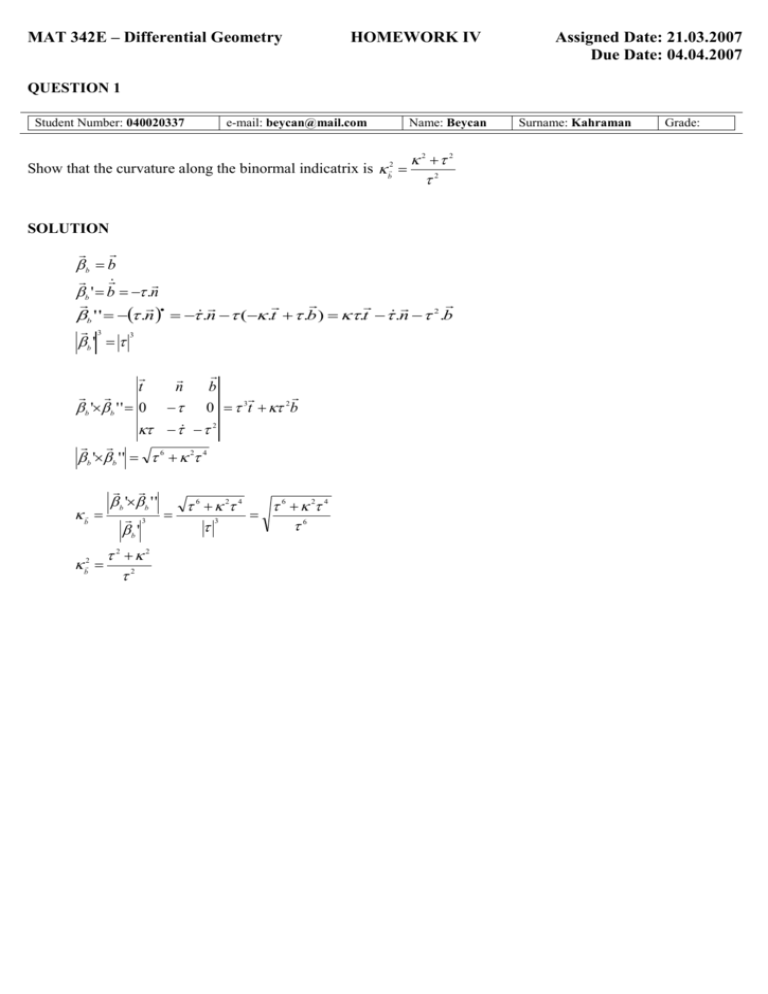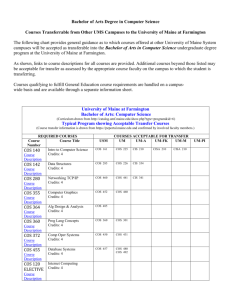MAT 342E – Differential Geometry HOMEWORK IV Assigned Date
advertisement

MAT 342E – Differential Geometry HOMEWORK IV Assigned Date: 21.03.2007 Due Date: 04.04.2007 QUESTION 1 Student Number: 040020337 e-mail: beycan@mail.com Name: Beycan Show that the curvature along the binormal indicatrix is b2 2 2 2 SOLUTION b b b ' b .n b ' ' .n .n ( .t .b ) .t .n 2 .b 3 b ' 3 t b ' b ' ' 0 n b 0 3t 2b 2 b ' b ' ' 6 2 4 b b2 b ' b ' ' b ' 3 2 2 2 6 2 4 6 2 4 3 6 Surname: Kahraman Grade: MAT 342E – Differential Geometry HOMEWORK IV Assigned Date: 21.03.2007 Due Date: 04.04.2007 QUESTION 2 Student Number: 040020337 e-mail: beycan@mail.com Name: Beycan Surname: Kahraman Show that the unit binormal of the involute * (c s)t of (s) is * .b .t b (c s) * SOLUTION * * ' * ' ' b * * so let’s find a way to calculate * ' and * ' ' . ' ' ' * (c s)t * ' (c s)t t * ' (c s) .n * ' ' (c s) n 2 (c s)t (c s)b * ' ' .n (c s ).n (c s) .n t 0 n (c s) b 0 2 (c s ) (c s) (c s) * ' * ' ' * ' * ' ' (c s) (c s) 2 2 2 2 3 2 (c s) 2 2 .t (c s) 2 3 .b 2 (c s)4 4 (c s)4 6 * ' * ' ' (c s) 4 4 ( 2 2 ) (c s) 2 2 2 2 * (c s) 2 2 .t (c s) 2 3 .b .t .b b (c s ) 2 2 2 2 2 2 But we have already find that, 2 2 * 2 2 (c s) * (c s) Therefore, inserting it in the equation we get: * .t .b .t .b . b 2 * 2 (c s) Grade: MAT 342E – Differential Geometry HOMEWORK IV Assigned Date: 21.03.2007 Due Date: 04.04.2007 QUESTION 3 Student Number: 040020337 e-mail: beycan@mail.com Name: Beycan Surname: Kahraman Find the equation of the involute of the helix (t ) a cos t.e1 a sin t.e2 bt.e3 , a 0 , b any constant. SOLUTION First of all, we have to check if (t ) is in its arc-length parametrized form: (t ) a cos t.e1 a sin t.e2 bt.e3 ' (t ) a cos t.e1 a sin t.e2 bt.e3 t t s ' ( ) d a 2 b2 d a 2 b2 t 0 t 0 s a 2 b2 s s .e1 a sin 2 .e b 2 .e3 2 2 2 a b a b a b Now let’s calculate t , a s a s .e t ( s) ( s) 2 sin 2 cos 2 2 2 1 2 2 2 a b a b a b a b s ( s) a cos 2 2 b .e2 .e3 2 2 a b The involute of the (s) is where c is a constant, then: * (c s)t s .e1 a sin 2 2 a b a b s * a cos 2 2 a s (c s ) sin 2 2 2 2 a b a b s .e2 b 2 .e3 2 a b a s .e1 cos 2 2 2 2 a b a b b .e2 .e3 2 2 a b The involute of the (s) is .e1 s bc .e .e3 2 2 2 2 2 a b a b a (c s ) s sin 2 2 2 2 a b a b a b * a cos s 2 2 s a sin 2 2 a b a (c s ) cos 2 2 a b where a 0 , b, c are constants. Grade: MAT 342E – Differential Geometry HOMEWORK IV Assigned Date: 21.03.2007 Due Date: 04.04.2007 QUESTION 4 Student Number: 040020337 e-mail: beycan@mail.com Name: Beycan Surname: Kahraman a) Show that the distance between corresponding points on two Bertrand curves is constant. b) Show that the angle between corresponding tangent lines on two Bertrand curves is constant. c) Prove that the product of the torsions of two Bertrand curves is constant. SOLUTIONS a) & * are Bertrand curves (mates), if * .n where is constant. * (s * ) (s) .n * (s * ) (s) .n * ( s * ) ( s) * (s0* ) (s0 ) constant. b) t * and t are both orthagonal to n n * . d (t * .t ) d (t * ) d (t ) * * ds* * t t t .t t .t ds ds ds ds ds* * d (t *.t ) ds* * * n .t n.t * n.t n*.t * 0 ds ds ds d (t *.t ) 0 ds t *.t c where c is constant. t *.t t * . t .cos c cos c is constant. Grade: c) * ' (1 )t .b * ' ' .t (1 )t .b .b * ' ' .t (1 ) .n .b 2 .n * ' ' .t ( 2 2 )n .b * ' ' ' .t .t ( 2 2)n ( 2 2 )n .b .b * ' ' ' .t .n ( 2 )n ( 2 2 )( .t .b ) .b .n * ' ' ' .t ( 2 )n ( 2 2 )( .t .b ) .b * ' ' ' ( 2 3 2 )t ( 2 )n ( 2 3 )b t b n 0 * ' * ' ' 1 2 2 * ' * ' ' ( 2 2 2 3 ).t ( 2).n ( 2 2 )(1 )b * ' * ' ' ( 2 2 2 3 ).t (2 2).n ( 2 2 2 2 3 2 2 )b * ' * ' ' ( 2 2 2 3 ) 2 (2 2) 2 ( 2 2 2 2 3 2 2 ) 2 2 2 3 2 2 2 3 ( * ' , * ' ' , * ' ' ' ) (1 )( 2 2 )( 2 3 ) ( 2 ) [ ( 2 ) ( 2 2 )( 2 3 2 )] ( * ' , * ' ' , * ' ' ' ) 1 ( * ' , * ' ' , * ' ' ' ) . . * * 2 ??? ' ' ' * 0 2 2









